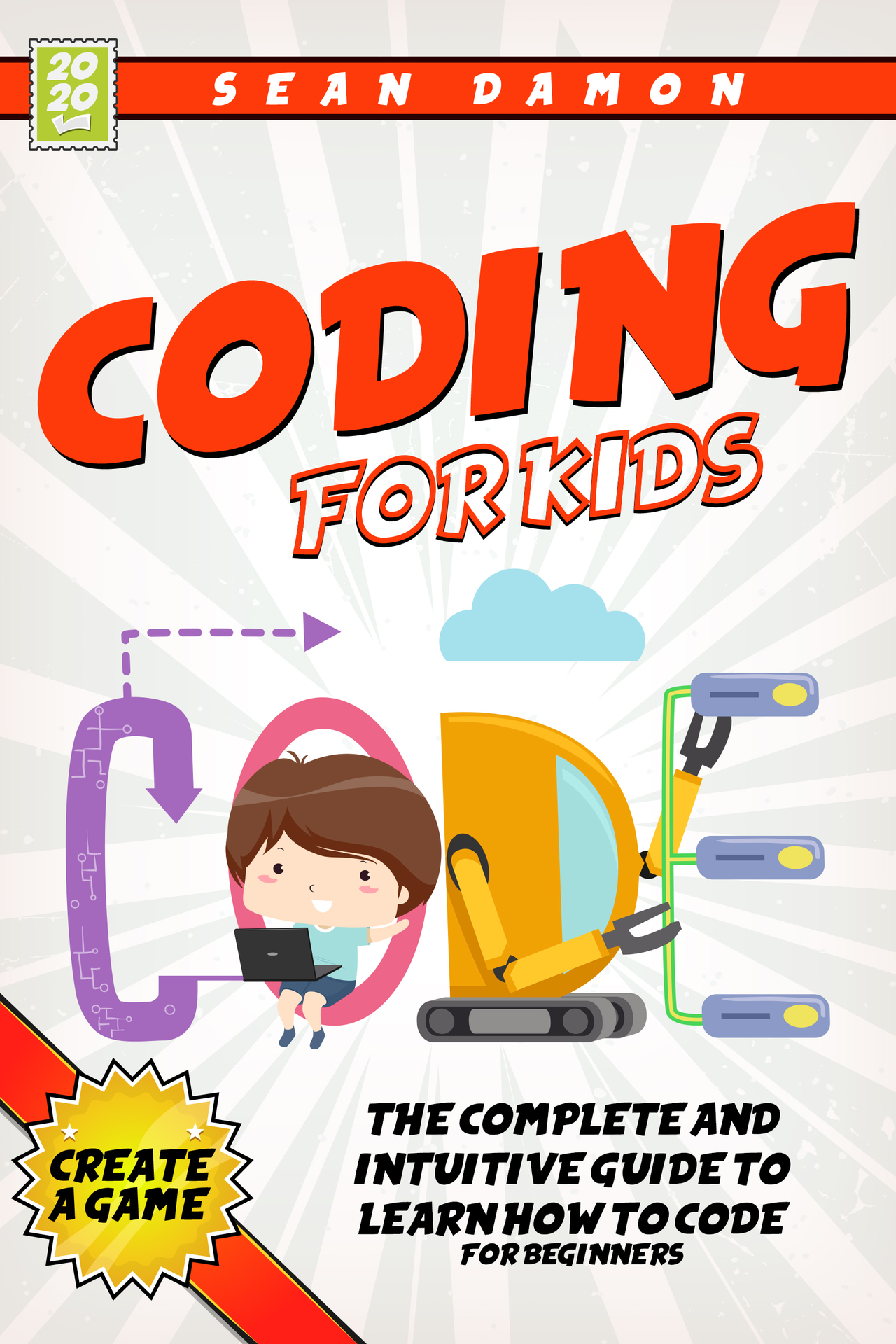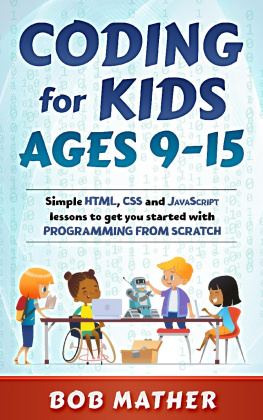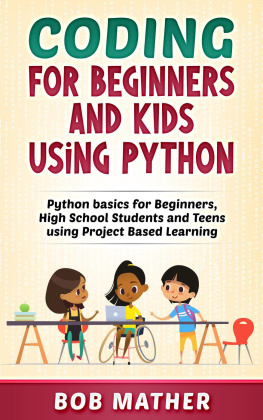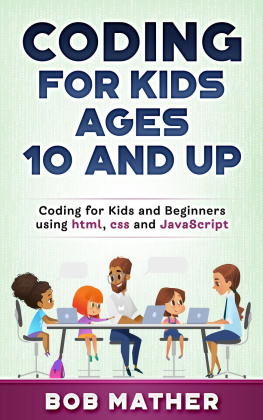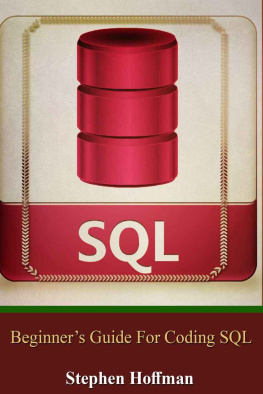CODING
FOR KIDS
The Complete and Intuitive Guide to Learn How to Code for Beginners
SEAN DAMON
Copyright 2020 - All rights reserved.
The content contained within this book may not be reproduced, duplicated or transmitted without direct written permission from the author or the publisher.
Under no circumstances will any blame or legal responsibility be held against the publisher, or author, for any damages, reparation, or monetary loss due to the information contained within this book. Either directly or indirectly.
Legal Notice
This book is copyright protected. This book is only for personal use. You cannot amend, distribute, sell, use, quote or paraphrase any part, or the content within this book, without the consent of the author or publisher.
Disclaimer Notice
Please note the information contained within this document is for educational and entertainment purposes only. All effort has been executed to present accurate, up to date, and reliable, complete information. No warranties of any kind are declared or implied. Readers acknowledge that the author is not engaging in the rendering of legal, financial, medical or professional advice. The content within this book has been derived from various sources. Please consult a licensed professional before attempting any techniques outlined in this book.
By reading this document, the reader agrees that under no circumstances is the author responsible for any losses, direct or indirect, which are incurred as a result of the use of information contained within this document, including, but not limited to, errors, omissions, or inaccuracies.
Table of Contents
Introduction
C oding is a good and useful skill that every child should learn. In later years, this skill may be used to create and develop great things. These things may be intended for entertainment during the childhood and teenage years. But, many of these things raise an interest in programming that can later be a solid basis for a career in computer science, engineering, or some other computer-related profession. These professions today are very popular among young people.
There are so many different programming languages, intended for creating different sorts of programs. The general rule is that any language can be used to make any kind of program. But, is it true? We will discover the answer to this question in this book. Some of these programming languages can be hard to learn, while others are as simple as the alphabet we learned as small children. Just keep in mind that every person (and this applies to children also) is an individual. Consider allowing them input when it comes to deciding which of the programming languages they like best. You should present them with a few, for example, Ruby, Python, and Java, explain to them the advantages and disadvantages are for each of them. Then, to keep it interesting, you might give them examples of programs and platforms they are familiar with and explain to them which programming language they are based on. For example, if you tell a child who has an account on Twitter that this social network was built using the Ruby programming language, they may become interested in learning more about Ruby, because this language is what made their favorite pastime possible. By learning about the programming languages that made their favorite games, applications, and social networks possible, they will also learn how to behave safely when it comes to computers and data they post on the Internet. So, this is another good thing that will come out of the first coding course.
Some program languages are very simple, like Python. This language looks more like a normal speech than like a programming language in the common sense of the word. That is why this program is very easy to learn and easy to use. It suits beginners best, but more experienced programmers can use it too. Lets examine why it is so easy to use. Coding is simple, although it may not look that way. That, in fact, is a common misconception about coding in any language, including Python. If you know how to give detailed instructions on how to do something (writing and sending an email to another person, for example), then you can learn how to code using the Python programming language. Its as simple as that.
When Installing Program is generally so easy, and in this day and age, many operating systems (Linux and UNIX for example) come with Program already installed as an integral part of the operating system, even some of the Windows computers (especially those manufactured by HP) now let us come with Program that already installed. When it comes to learning how Program works, how to use it, and what it can do for us, you have a variety of sources to choose from. You can learn it all by yourself, reading books, or using help available on the Internet. These could include online courses, eBooks and even blogs written by experienced programmers who wanted to make things easier for you as a beginner. When starting out, its wise to take a look at freely available online information. Furthermore, there are countless online tutorials available to move on to after reading this book, and many of these tutorials are cost-free and intended specifically for beginners. Nearly every program developer that has any level of success in creating programs tends to share their success with the rest of the world. This is done mostly through blogging and videos and tutorials posted on YouTube. You can follow their blogs, or watch the instructional videos they post on YouTube. That way, you can easily learn the basics of any programming language and its syntax, because, these people post very detailed videos/texts, explaining every single aspect to the core. There are also options to chat with them. That way, you can ask them for an explanation of Pythons syntax if that is what you are interested in. If you are working on a Python-based program or project, and you encounter difficulties using it, you may ask some of these bloggers for advice or help in solving your problem.
Another way of learning about Python and how it works is the search on an Internet library with copious amounts of Python tutorials. This library or database is called the ActiveState Python Cookbook. This is a certified tutorial book collection available on the official Python website. There are many instructional tools available (including videos for visual learners) there which can be useful to you and the children in your life, and can easily be paired with the other resources mentioned earlier in this phase to create a solid basis for getting started with coding in Python. In the end, the choice of learning method is entirely up to you. Use the one that you feel its the best for you or your students.
One important thing you should know about using Python is that it is free. You are not required to pay any kind of fee to use it. Python is a part of the so-called open source concept. This is a concept that has one goal: to bring programs to you as end-users, without demanding a charge for it. If you download something that is open source, this is completely free. This allows us to use the latest programming innovations to our advantage and for our benefit. In practice, the choice of the programming language is often dictated by other real-world factors. I have mentioned the so-called YouTubers posting their video tutorials before. These people show you how one programming language works by giving you instructions using a simple example for nearly every field covered by a given programming language. If you are a visual type when it comes to learning, then this is ideal for you. They show you every step that needs to be taken and also explain the meaning of every word/symbol used for writing code. You might want to explore what these examples are and give them a try yourself. That way, you (or your students) can learn from practical experience how to make programs, not just in Python, but in any other computer programming language. Use the source code on your system freely.

